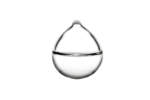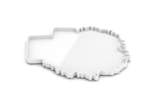thoughts and suggestions of 5.5 designers
5.5 designers is a design studio started up in 2003 by Vincent Baranger, Jean-Sébastien Blanc, Anthony Lebossé, and Claire Renard. Far from focusing only on shaping objects, the 5.5 designers force themselves to a conceptual rigour and a permanent questioning on what their designer status is. Because of this approach, tinted with humour and simplicity, brands and editors, from luxury to mainstream ones, ask them to design products and sceneries for their spaces.

area: During the elaboration phase of a cooking-related design object, what is the most important aspect, functionality or aesthetics?
5.5 designers: Today, in every area, from cooking to computers, both aspects are important. A merely functional object is boring, but when it’s excessively designed it’s useless. It’s all about finding the right balance between those two components. Things become even more complicated when we factor in the semantic aspect, i.e., the meaning we want to give to the object. Today, we also have to create objects that tell a story, and that dimension is essential in the way we practice design. We don’t try particularly hard to create a beautiful object, but we care a lot about creating a product that elicits emotion by questioning our traditions and customs. Aesthetics is often a result of what we are trying to communicate. In the cooking world traditions are engrained, and we cannot limit ourselves to being beautiful and functional if we want to touch as many people as possible. This additional component is what justifies the involvement of the designer in a culinary project.
area: Is the designer’s creative gesture guided mostly by the desire to meet the requirements of functionality, or to satisfy feelings of pleasure and taste?
5.5: Our design is mostly about creating surprise and amazement. We constantly try to propose objects that shock and question our habits. And the pleasure we take in enjoying a new culinary experience stems from that difference. We like to offer consumers objects that stimulate our taste buds, challenge our senses to discover new sensations. The functional purpose is a prerequisite that has to be fulfilled before imparting that sensorial dimension.
area: Do you think it is possible to subvert the relationship - established and consolidated over time - that exists between cooking objects and the materials out of which they have traditionally been made (glass glasses, porcelain or ceramic plates, metallic cutlery…)? How do these materials affect the production of design objects? If the relationship between typology and material is so strong, it’s because each material imposed itself as the most adapted to an easy and profitable function and to practical everyday use. Generally, and from an aesthetically conservative point of view, metallic dishware remains camping dishware, plastic dishware is disposable and porcelain china is for special occasions. We are obviously free to challenge these conventions, and the evolution of techniques and behaviors makes it possible today to consider creating porcelain glasses, metallic plates and glass cutlery, but it remains an isolated practice, and it will never become more practical than having a glass made from glass. I think that if we want to influence traditions – which are a bit intimidating for a designer, I have to say –, it is more relevant and more realistic to consider creating new types of culinary objects, which will bring new materials to the table. In short, we prefer to ask ourselves how we will be drinking tomorrow, how we will get food into our bodies, before asking ourselves what shape we can give to a piece of dinnerware. This approach is what will modify our culinary practices, as well as the tools we use to satisfy our vital need to eat.
area: According to you, which companies and producers are most concerned about research, and consequently more favorable to and interested in investing in the design sector?
5.5: The companies that are more interested in research are surprisingly the most traditional ones, those that have a rich legacy. These companies have always been able to evolve and to challenge their way of working, without renouncing their history. Companies that surf on the current design wave release products that are unusual but not, in our opinion, the result of a true research process. Research implies involving different actors from different areas, each bringing his or her own knowledge and savoir-faire to bear on a given problem. The goal is not to do something different for the sake of being different and of standing out. Genuine research work has to rely on previous gains and to set a new standard for the brand, a standard on which the company can capitalize. Our collaboration with Hennessy is a true research project in that way; we have had to share and discuss with the tasting committee, which is rather traditional, but also with environmental experts and of course with marketing representatives, who remain our main contacts.
area: What objects have inspired you most? In your opinion, who are the true masters as far as food is concerned? What objects have truly had an impact on the history of food-related design?
5.5: It’s always hard to tell where our inspiration comes from, and this question is intriguing to many scholars: how creativity is born, what internal phenomenon of human nature is responsible for the generation of ideas. I think that, more than other designers, our lifestyle and the people we meet are what inspire us and provide answers to our questions. And of course, we have the greatest admiration for some creators in the culinary world. I will mention Ferran Adrià, whom we were lucky to meet and with whom we had an exchange in South Africa during a conference organized by Design Indaba, or else Christophe Michalack (the pastry chef at the Plaza Athénée hotel in Paris), with whom Claire, one of our partners, collaborated on various projects which didn’t pan out, but which remain genuine research in our view.
area: What are the most important cooking products you have designed so far?
5.5: On the one hand, there are edible products, and I think that our latest collaboration with Chocolat Factory will bring a new dimension to chocolate. And of course, the sugar handle, from the collection of everyday objects, which makes it possible to turn any glass or plastic cup into an authentic coffee cup. And on the other hand, there are non-comestible objects, which showcase food; in this category we could mention “les vices de la déco”, the one-of-a-kind items coming from the “Ouvriers-designers” workshop and released by Bernardaud, and of course our Apparat collection, created for Baccarat. But the best is yet to come: we are working on various projects in this area, including a complete range of ten small affordable appliances – including a potato masher, a toaster, a coffee pot, a grill, a citrus squeezer and a hot water bottle – for the Moulinex brand, part of the SEB group. We just developed a collection of seven plates, entitled DAILYMENU, for KHALA, the German porcelain brand, and we are working on a coffee tasting kit for a major brand whose name we cannot yet disclose.

























